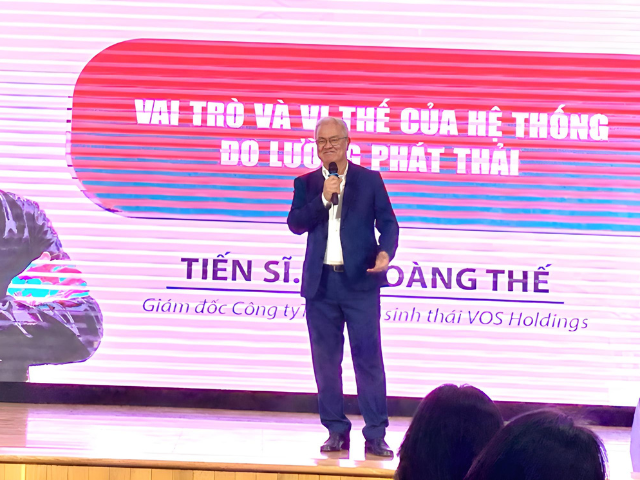At the seminar on “Green Finance and Carbon Credit Exchange,” Mr. Le Hoang The, Director of VOS Holding Ecological System Co., Ltd., emphasized that to obtain carbon credits, enterprises must establish a proper procedure, with MRV as the core of the certification dossier.
According to Mr. The, the journey of developing a carbon credit-worthy project starts with enterprises determining the standard to pursue, followed by measuring emissions and emission reductions. The project needs to have a clear legal dossier, including business licenses, output contracts (such as solar and wind power…), environmental and social impact assessments, and commitments to comply with sustainable development principles.
An important point in the technical dossier is determining the “baseline emissions,” which are the emissions before the project’s intervention. This is the basis for calculating the amount of greenhouse gas reduced after implementation. Mr. The gave an example: “If a power plant previously used coal and now switches to solar power, the emission difference between the two options is what is recognized as carbon credits.”
Once the dossier is complete, enterprises need to develop an MRV plan to monitor emissions, collect data over time, prepare reports, and invite an independent organization to evaluate. This is a crucial step to validate the reduced emissions, ensuring they are measurable and comply with international standards. The more accurate and comprehensive the MRV is, the higher the chance of obtaining credits.
“Imagine this like a birth certificate or our declaration,” Mr. The illustrated, emphasizing the pivotal role of MRV in ensuring the project’s reliability. Only when the reduced emissions are accurately measured and verified can the project be recognized. The MRV confirmation serves not only as a technical basis but also as a foundation for the credit-buying side to assess the project’s environmental effectiveness. This requires MRV to ensure data integrity and consistency throughout the implementation process.
 Mr. Le Hoang The sharing at the event. Photo: Tu Kinh
|
After MRV, the dossier will be reassessed by a Designated Operational Entity (DOE), such as TUV Nord, DNV, Intertek, or Control Union. Usually, the carbon credit issuer designates these organizations. They will evaluate the entire process, from the dossier to the actual site. If the project meets the requirements, the enterprise will receive an official carbon credit certificate, be registered with a number, and be uploaded to a database, forming the foundation for carbon credit transactions.
Sharing the same view, Mr. Nguyen Huy, General Director of Certification and Food at Intertek Vietnam, stated that MRV is a prerequisite for proving a project’s “greenness.” However, he warned that many Vietnamese enterprises are unfamiliar with the process, leading to potential errors in reporting emissions.
Mr. Huy mentioned that greenhouse gas emissions measurement is currently carried out within three scopes. The first scope includes direct emissions from activities controlled by the enterprise, such as fuel combustion. The second scope covers indirect emissions from purchased energy, such as electricity from the grid. The third scope involves indirect emissions from the entire supply chain, including raw materials, transportation, and consumption. To calculate emissions accurately, enterprises need to collect activity data such as electricity, fuel, and raw material bills and apply emission factors published by international organizations like the IPCC or the former Ministry of Natural Resources and Environment.
A common mistake, according to Mr. Huy, is enterprises reporting incomplete data or “rationalizing” it, leading to inaccurate reports. Once submitted, this data cannot be retracted or “amended” like financial reports. The biggest challenge, he emphasized, is not in the calculation technique but in ensuring transparency and honesty when providing information. Careful consideration is also necessary when choosing the baseline year for comparison, as the years 2021 and 2022 may not be suitable due to the abnormal impact of the COVID-19 pandemic.
Additionally, with new regulations like the EU’s CBAM coming into force, a lack of a robust MRV system could hinder enterprises’ export opportunities and access to international capital. Mr. Huy shared that for Intertek, environmental criteria account for 15% of the total KPI for evaluating global performance, and many large corporations have integrated emission criteria into the KPI for bonuses for their leaders.
Carbon Taxation: Which Industries Will Be Affected?
What Does the EU’s Carbon Border Adjustment Mechanism Mean for Vietnamese Exports?
According to the two experts, investing in MRV is not just about obtaining carbon credits but also a strategic step for enterprises to survive and compete in a low-carbon economy. In the near future, enterprises without transparent and standardized emission dossiers will face barriers not only in international markets but also domestically, where a domestic carbon credit exchange system is taking shape.
Get Ready for the CBAM ‘Playing Field’ in the Race to Green the Economy
– 08:35 26/05/2025
Why Are Many Businesses Buying Carbon Credits Instead of Reducing Emissions Themselves?
In the midst of a growing global push for Net Zero commitments, the carbon credit market is experiencing a surge in demand from businesses. A prevalent trend sees companies opting to purchase carbon credits as an alternative or supplementary solution, rather than solely focusing on direct emission reductions in their production operations. This development raises questions about the motivations behind these decisions and the potential implications for the trajectory towards achieving net-zero emissions by 2050.
“Securities and Carbon Credits: Exploring Their Viability as Collateral”
Experts unanimously agree that there is an urgent need to develop a comprehensive legal framework that recognizes and regulates digital assets and carbon credits in banking practices.
The End of the Road for Gas Guzzlers: A Line-Up of Fuel-Powered Cars Faces the Axe
The automotive industry is facing a significant shift with the implementation of upcoming fuel consumption limits. Manufacturers and dealers must adapt to these changing standards or risk having their vehicle models taken off the market. This development will undoubtedly impact a wide range of car and motorcycle designs, urging a necessary evolution in the industry.
The Fresh Vietnamese Milk Producer’s Pledge: Carbon Neutrality and Net Zero
At a recent Carbon Neutrality Certification Ceremony, representatives from the TH Group (owners of the national brand TH true MILK) announced their commitment to maintaining carbon neutrality at two of their member units – TH Milk Joint Stock Company and Nui Tien Pure Water Limited Company. The companies will uphold this status according to the PAS 2060: 2014 standard until 2028, after which they aim to achieve neutrality in accordance with ISO 14068.





















